Historically in Ireland, pregnancy was viewed as a normal physiological event with female relatives, friends and the local midwife being present and assisting during the labour and birth (O'Connell and O'Connell, 2020). By the early 1900s, women began to opt for a hospital birth, believing that modern medicine would improve safety and wellbeing (O'Connell et al, 2022). Over time, this move has resulted in a loss of unique midwifery skills and a rise in the medicalisation of pregnancy and birth (O'Connell et al, 2022). This has led to childbirth being viewed as an illness, resulting in the use of routine, inappropriate interventions and practices that affect normal physiological labour (Côrtes et al, 2018). To reclaim childbirth as a normal physiological event, the World Health Organization want midwives to take ownership of and be the lead healthcare professionals in supporting normal pregnancy and birth (Côrtes et al, 2018).
With advances in three dimensional models of the human body exploring how it works and moves, there has been a rise in different professionals investigating the workings of the pelvis during labour and birth. This has provided maternity healthcare professionals with a better understanding of the effects of pregnancy hormones and the biomechanical changes that affect the abdominal muscles and spinal curvatures (Conder et al, 2019). These studies have demonstrated that obstructed labours are a mechanical imbalance in the pelvis that results in the fetus' position not being the best fit to negotiate the pelvis (Hemmerich et al 2019; Grimm, 2021; O'Brien, 2023). The bony pelvis and soft tissues then fail to alter and thus prevent the fetus from descending (Feltovich, 2019). Upright positions, squatting and mobilising maximise the effect of gravity and the effectiveness of contractions (O'Brien et al, 2022). These enable the bones of the pelvis and the lower back to alter, increasing internal pelvic diameters and facilitating the fetus to fit better, descend, rotate and be born (Berta et al, 2019; Desseauve et al, 2019; Hemmerich et al, 2019; O'Brien, 2023).
Understanding biomechanics provides maternity caregivers with the opportunity to inform women and provide an antenatal exercise regime that ensures the pelvis is mobile and ready for labour and birth (Clarke-Patterson et al, 2022). This antenatal preparation suggests childbirth is like running a marathon, and so should not be undertaken without proper training (Desseauve et al, 2015).
One of the tools used in Irish maternity services to prepare for labour is the ‘labour hopscotch’ tool (Figure 1). This is a visual tool that encourages women to move and remain active antenatally and during labour, and to use water and complementary therapies to help facilitate labour and birth (O'Brien et al, 2022). By sharing this information, women can practice the steps of labour hopscotch antenatally, facilitate optimal fetal positioning, enhance the chance of the spontaneous onset of labour, be cognisant of the various props that can be used during labour and avoid unnecessary interventions that could disrupt the normal physiology of labour (Carroll et al, 2022).
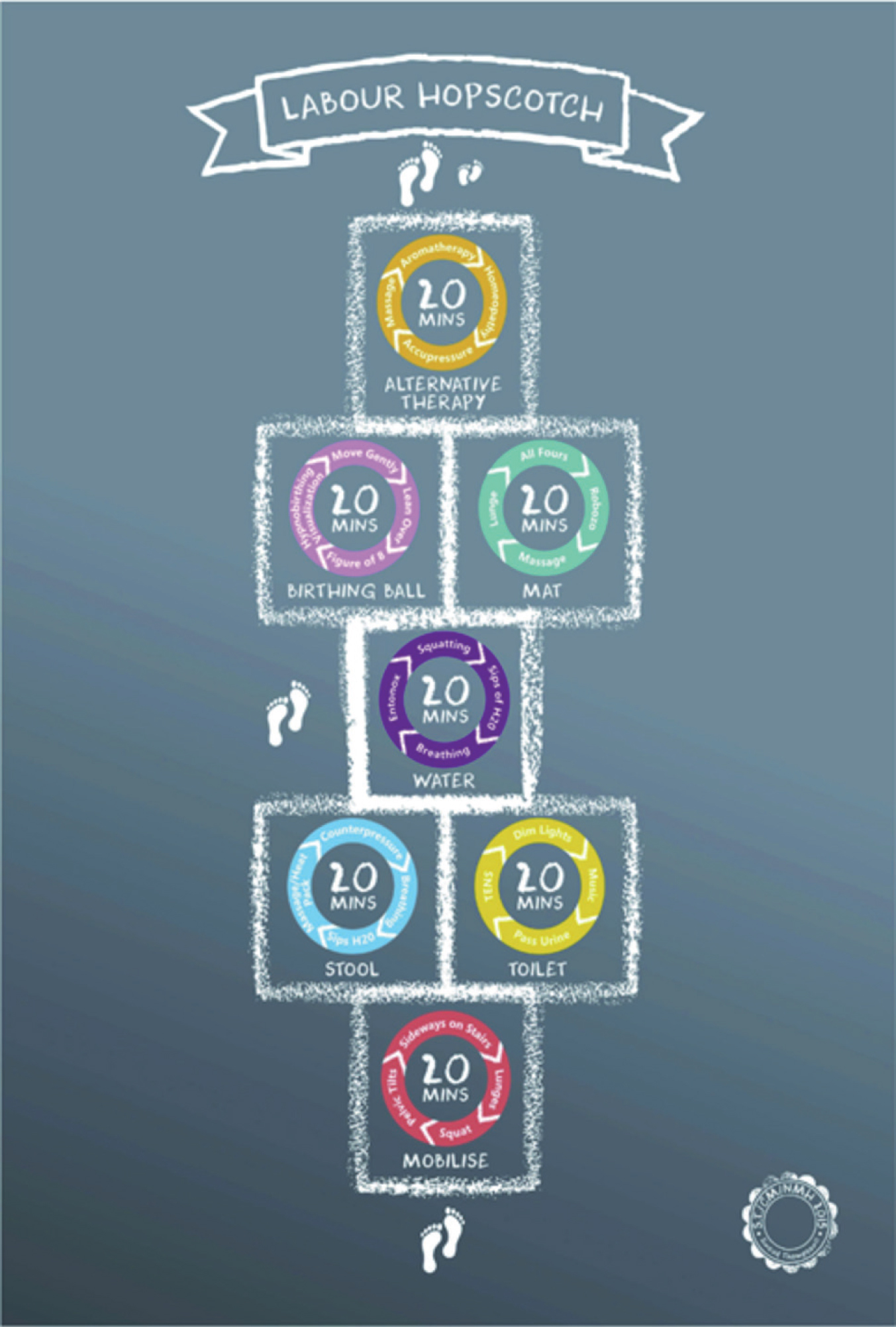
Labour hopscotch has been used and shared with women as an aspect of care provided by an advanced midwife practitioner in Ireland since January 2017. A national directive has seen the tool incorporated into all Irish maternity services since 2020. The focus is on gentle exercise, complementary therapies and using a birth ball for sitting on antenatally and intrapartum (O'Brien et al, 2022). Birthing balls have been used for labour and birth since the 1980s. There is conflicting evidence and limited data on their impact in relation to shorter first and second stages of labour and higher vaginal birth rates (Grenvik et al, 2023). They are cheap, reusable and provide a reduction in pain score, with women who use birth balls reporting a positive birth experience (Delgado et al, 2019).
Since September 2022, the toolkit ‘biomechanics for birth’ (O'Brien, 2023) has been shared with women attending for advanced midwife practitioner care from 26 weeks' gestation. This tool informs women of how to optimise fetal positioning by undertaking 20 minutes of exercise daily, wearing a good fitting bra, having good body posture, using the ball from 26 weeks to keep the hips and pelvis mobile and using rebozo, side lying releases, lunges and squats to train for labour and birth (O'Brien, 2023). All women receive a copy of the biomechanics for birth toolkit by email and labour hopscotch is discussed at each visit. Both tools are used during labour. Having the freedom to mobilise in labour, choose upright birth positions and being cared for by a competent, supportive caregiver resulting in a positive birth experience and maximises the chances of a vaginal birth (O'Brien et al, 2022).
After several months, the advanced midwife practitioner at the service noticed that there was reduction in women having pelvic girdle pain in the final weeks of pregnancy, as the fetus had entered the pelvic brim. There was also a noticeable reduction in women birthing after 41 weeks' gestation and therefore fewer women needing a plan for induction. Based on these observations, it was decided to undertake a retrospective study to ascertain if this new intervention had resulted in any noticeable differences.
Women attending an advanced midwife practitioner service in Ireland have received information and education about labour hopscotch and fetal optimal positioning since 2017 (Carroll et al, 2022). Following a healthcare professional training day in the biomechanics for birth toolkit, led by Molly O'Brien in September 2022, information sharing and education about biomechanics for birth (O'Brien, 2023) has also been included. This has provided extra resources and activities for the service users to prepare themselves for labour and birth (O'Brien et al, 2022).
This retrospective study of one advanced midwifery practitioner service aimed to determine if the introduction of biomechanics alongside labour hopscotch resulted in more spontaneous onset of labour, fewer inductions of labour and a higher vaginal birth rate. Labour hopscotch has been shown to faciltate choice, enhance decision making and optimise fetal position for labour and physiological birth (Carroll et al, 2022), but it was felt that the addition of biomechanics to the woman's antenatal preparation had impacted on spontaneaous onset of labour rates and gestation at onset of labour. The objectives were to explore whether there were any differences before and after the introduction of the toolkit in:
- The number of women having a spontaneous onset of labour before 41 weeks' gestation
- The number of women being induced
- The number of women being induced resulting in caesarean section birth
- Birth outcomes for Robson groups 1–5.
The Robson classification is a global standard that assesses, monitors and compares birth outcomes, classifying all pregnant women into 10 groups based on their obstetric characteristics of parity, gestational age, fetal presentation and previous caesarean section (World Health Organization, 2017). Only groups 1–5 were included in this study, as these are the groups that reflect the advanced midwife practitioner caseload. The groups are split as follows:
- Group 1: nulliparous, singleton, >37 weeks' gestation, cephalic presentation with spontaneous onset of labour (n=42 pre-intervention, n=56 post-intervention)
- Group 2: nulliparous, singleton, >37 weeks' gestation, cephalic presentation with induction of labour (n=31 pre-intervention, n=7 post-intervention)
- Group 3: multiparous, singleton, >37 weeks' gestation, cephalic presentation with spontaneous onset of labour (n=42 pre-intervention, n=44 post-intervention)
- Group 4 are multiparous, singleton, >37 weeks' gestation, cephalic presentation with induction of labour (n=25 pre-intervention, n=29 post-intervention)
- Group 5: multiparous, singleton, >37 weeks' gestation, cephalic presentation with a previous caesarean section scar (n=15 pre-intervention, n=18 post-intervention).
Methods
A retrospective review of all pregnancy records at the advanced midwife practitioner service was undertaken. The pre-intervention group (labour hopscotch) included all women who attended the service for all antenatal care and birthed in an Irish maternity unit between 1 January and 30 September 2022 (n=155). The post-intervention group (labour hopscotch and biomechanics for birth) included all women attending the service between 1 January and 30 September 2023 (n=154).
Data collection
A student midwife and the advanced midwife practitioner collected the data. All women who attended and birthed during the stated time were included. Pregnancy records were obtained and data collected using the local pre-existing labour and birth audit questionnaire. The collected data were age, parity, gestation, Robson group, onset of labour, mode of birth and reason for induction of labour, if applicable.
Data analysis
Data analysis was performed and written up in conjunction with the local clinical audit support team in December 2023. The data were cross-checked by the team and reported as frequencies and percentages.
Ethical considerations
Ethical approval was not required, according to the local research and education committee. To comply with local guidelines pertaining to clinical audit, a proposal form was completed and submitted to the local clinical audit support team prior to commencing the study.
Results:
Pre- and post-intervention groups' characteristics
The demographics for age (Figure 2) and parity (Figure 3) were similar in both groups but not statistically tested. The majority of women were 30–40 years old, with a parity of 1 (41.2%) being highest in the post-intervention group and a parity of 0 (35.9%) highest in the pre-intervention group.
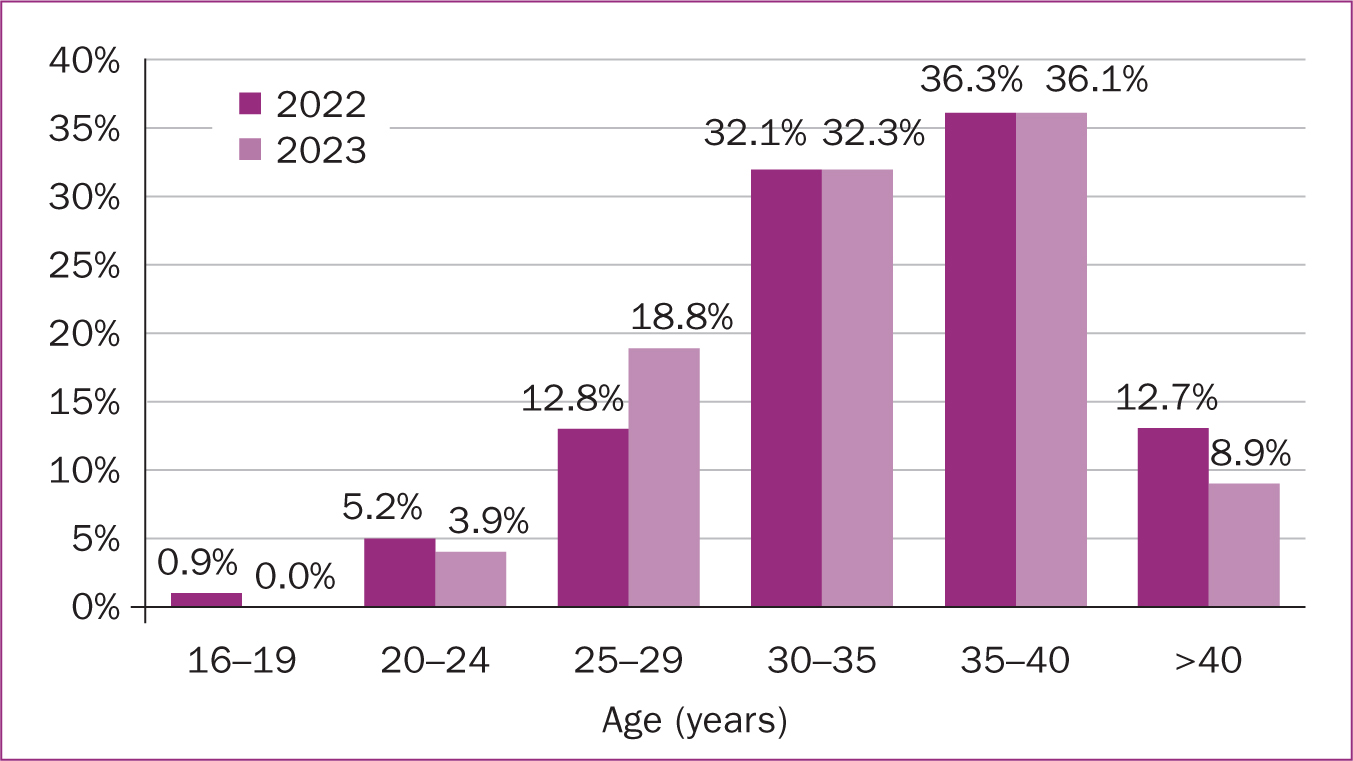
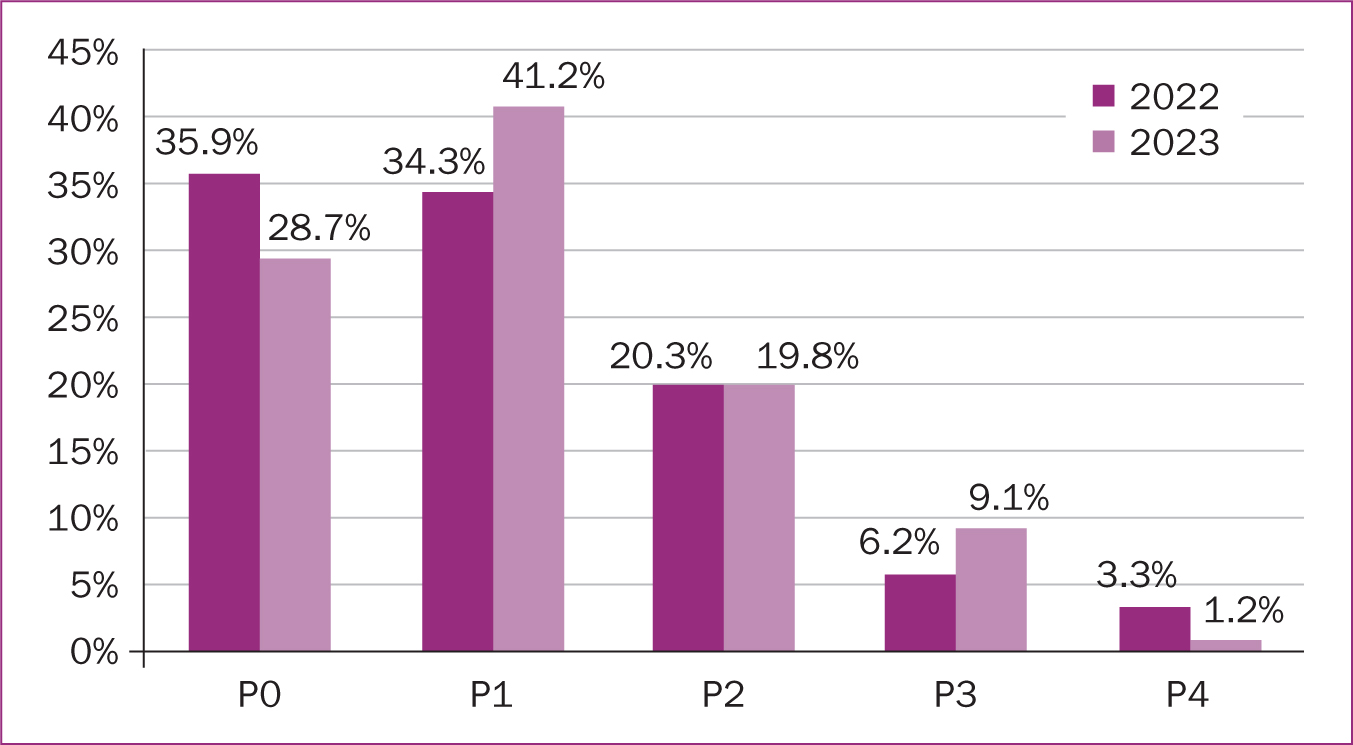
Robson groups
Figure 4 compares the proportion of women in the five Robson groups: group 1 (n=42 pre-intervention, n=56 post-intervention), group 2 (n=31 pre-intervention, n=7 post-intervention), group 3 (n=42 pre-intervention, n=44 post-intervention), group 4 (n=25 pre-intervention, n=29 post-intervention) and group 5 (n=15 pre-intervention, n=18 post-intervention).
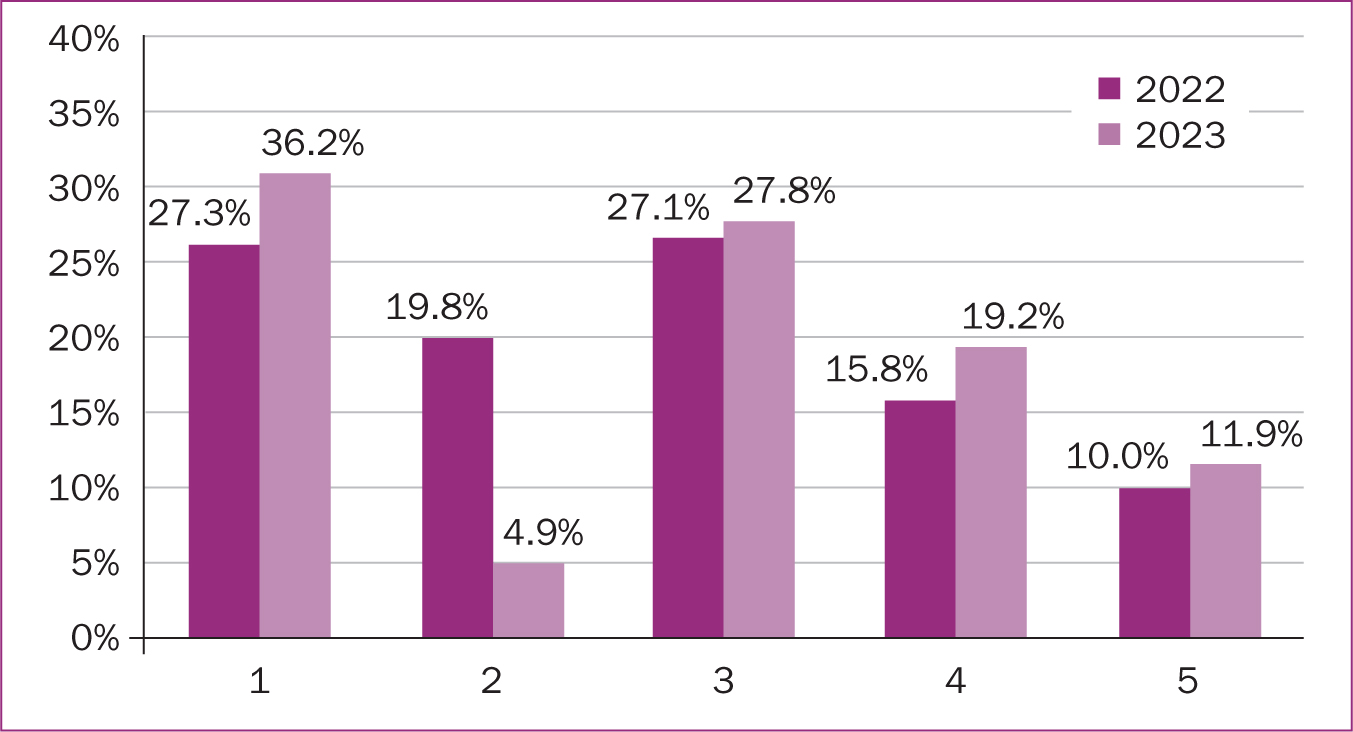
The overall number of nulliparous and multiparous were similar between the years. However, there were more nulliparous women in group 2 pre-intervention (31 v 7), with post-intervention having a higher proportion of caesarean section births. Numerically, group 2 resulted in 13 caesarean section births in 2022, with five caesarean section births in 2023.
Spontaneous onset and induction of labour
In the pre-intervention group, 57.2% of women had a spontaneous onset of labour with 33.2% birthing before 41 weeks' gestation (Figure 5). In the post-intervention group, 72.2% of women had a spontaneous onset of labour, with 91.8% birthing before 41 weeks' gestation (Figure 5).
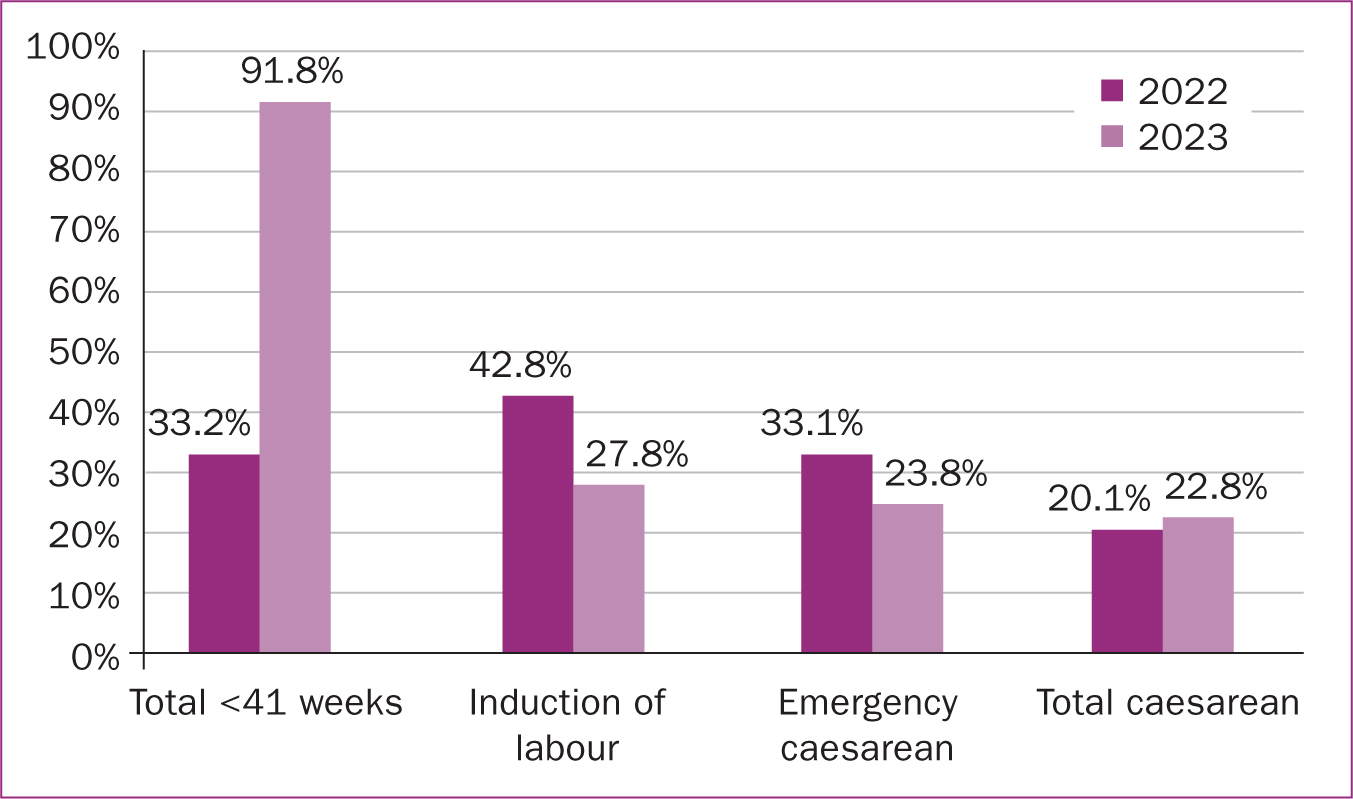
Birth outcomes
In the pre-intervention group, 42.8% of women had their labour induced, with 33.1% having an emergency caesarean section following induction (Figure 5). In the post-intervention group, 27.8% had their labour induced, with 23.8% having an emergency caesarean section birth following induction (Figure 5). This was a 15.0% reduction in the rate of inductions and a 9.3% reduction in caesarean section birth following induction. The overall rate of caesarean section in the pre-intervention group was 20.1% and 22.8% in the post-intervention group (Figure 5). In the Robson groups, there was a 4.4% rise in vaginal birth in group 1 and a 2.7% rise in group 3 (Figure 6).

Discussion
Worldwide, midwives are experts in supporting normal pregnancy and birth (O'Connell et al, 2022). They are responsible for health and antenatal education, and are trained to recognise deviations from the norm, intervene and escalate care to the obstetric team (O'Connell et al, 2022). They provide support and care from conception and up to 6 weeks post-birth in partnership with the woman, informing and empowering her to make choices to optimise her birth outcomes (O'Connell et al, 2022). Informed decision making can be achieved by women receiving robust, evidence-based information and education throughout pregnancy from midwives who encourage mental and physical antenatal preparation, including fetal optimal positioning, and who support physiological birth and active upright labours (O'Brien et al, 2022).
Regular exercise is vital for physical and psychological health (Chan et al, 2019). Antenatal exercise contributes to fitness required for a healthy pregnancy (Catov et al, 2019). Gascoigne et al (2023) reported that 55% of women stop exercising in pregnancy, with only 21% partaking in regular physical activity. They halted exercise in case it would harm the developing fetus (Gascoigne et al, 2023). By informing women of the benefits of exercise in reducing pregnancy complications, improving mental health, reducing backache and increasing the chance of spontaneous labour and vaginal birth, midwives are in a unique position to motivate and have a positive impact on the future health of the woman and her family (Gascoigne et al, 2023). Through education by a midwife, a pregnant woman can develop an exercise regime that suits her lifestyle and personal preferences, while helping her to achieve fetal optimal positioning and a physiological birth (Brown et al, 2022). Exercise regimes have been shown to result in higher spontaneous onset of labour, enhance the effectiveness of the uterine contractions and have a higher vaginal birth rate (Carroll et al, 2022).
In the present study, the addition of the biomechanics for birth toolkit and recommended weight gain has shown a significant difference, with 57% of women having spontaneous onset of labour before introduction of the toolkit and 72% having spontaneous onset after its introduction. There was also an increase in women birthing before 41 weeks, from 33% to 92%. Women should be educated about the benefits of pregnancy exercise and encouraged to partake in at least 30 minutes a day (Wadhwa et al, 2020). A decrease in physical activity in pregnancy can result in more pelvic girdle pain, weight gain and poor sleep patterns (Chan et al, 2019). The World Health Organization recommends 120–250 minutes of moderate physical activity per week in pregnancy (Chan et al, 2019). This reduces ankle swelling, cramps, low mood, general fatigue, postnatal depression, weight gain, induction of labour and having a caesarean section birth (Golawski and Wojtyla, 2022).
Induction of labour is a common intervention that increases the risk of caesarean section from around 6% for spontaneous onset of labour to 13–45% for Robson group 4 and 36–57% for group 2 (Saolta, 2023). In the present study, there was a rise in emergency caesarean section of 22% post-intervention for women in Robson group 2. However, the large reduction in the number of nulliparous women requiring induction post-intervention should be noted; there were 31 women in group 2 before the intervention and 7 women after the intervention. Group 4 showed a 3% rise in emergency caesarean sections, with similar numbers of women in groups 3 and 4 before and after introduction of the toolkit. However, the large increase in women birthing before 41 weeks post-intervention should be noted, and the reduction to the induction of labour emergency caesarean section rate from 9% to 24%.
Randomised control trials or systematic reviews into the use of birthing balls are limited (Yeung et al, 2019), with studies contradicting one another's findings. However, when the ball is used, it has been reported that maternal satisfaction scores are high and there is a decrease in labour pain scores (Makvandi et al, 2018; Borg and Hill, 2023; Grenvik et al, 2023). Women who use the birthing ball before and during labour have been shown to have free movement of the pelvis, assisting the fetus to rotate and successfully descend and be born (Zhang et al, 2022). Labour hopscotch and the biomechanics for birth toolkit focuses on regular use of the ball antenatally and intrapartum. All women attending for advanced midwife practitioner care have been signposted to using the ball regularly for sitting, with documented evidence from their pregnancy record that they did use the ball. The biomechanics for birth group were further encouraged to use the ball to perform hip circles and figures of 8 from 26 weeks. Based on the outcomes of this study, recommending and encouraging use of the ball should continue throughout the pregnancy and during labour. The findings also identified the need for a research study to further explore what motivates women to use the labour hopscotch and biomechanics tools and their experiences of compliance.
The use of rebozo antenatally and during labour has been shown to correct fetal malposition by relaxing pelvic muscles and ligaments and realigning the fetus into a better position to navigate the pelvis (Cohen and Thomas, 2015). Ascertaining how many women use rebozo was not part of this study but is included in labour hopscotch and biomechanics for birth; however, it is not commonly used in Irish maternity units. It is a well-established and researched intervention in South America, with positive user feedback and high vaginal birth outcomes (Iversen et al, 2016). This needs to be explored further to ascertain if it has a positive outcome in Irish maternity settings.
Limitations
This was not a trial but a small-scale study that may not be replicable in other models of care. All participants received continuity of care from the advanced midwife practitioner with biomechanics, exercise and labour hopscotch being discussed at each appointment from 26 weeks on. The women were encouraged to incorporate labour hopscotch and biomechanics into their daily routine and to continue to use them in labour. The study design did not capture how many did use the tools antenatally and intrapartum. This will be further explored to investigate women's experience of using these birth preparation tools.
The present study did not investigate how long women exercised for or whether those that exercised noticed a difference in their mental health or leg problems. This will be added to the audit tool, and there is a need to combine the audit tool used to assess compliance to recommended weight gain in pregnancy with the audit tool used for the present study.
Conclusions
With the majority of births in Europe now occurring in maternity units, and pregnancy and birth being increasingly medicalised, alongside a rise in routine electronic fetal monitoring and the resulting cascade of interventions that arises from this practice, it is time for midwives to be the lead carers in normal physiological birth. Maternity care providers should value the importance of healthy eating and exercise and use pregnancy to promote these practices to avoid excess weight gain in pregnancy, as well as optimise fetal position antenatally, facilitate spontaneous onset of labour and reduce caesarean section births. Exercise should be encouraged throughout pregnancy, focusing on the physical and mental maternal health benefits. This can be achieved through midwife education and by midwives encouraging the women they care for to participate in pregnancy exercise, labour hopscotch and biomechanics for birth antenatally. This will encourage the fetus into an optimal position and increase the chance of spontaneous labour. It can also give women a sense of control, and with the help of a supportive and knowledgeable birth attendant, will continue to embrace mobility and upright positions in labour. This will ensure women are not passive recipients but rather actively involved, to maximise the chances of a physiological labour and birth. The overall result is a positive birth experience with high levels of maternal satisfaction based on being fully informed and enabled to make choices and plan care. This study identified several research study opportunities that will provide an insight into women's experiences of using labour hopscotch and biomechanics for birth.
Key points
- Antenatal education and information sharing about the importance of regular exercise throughout pregnancy and preparing for labour using fetal optimal positioning, the labour hopscotch tool and the biomechanics for birth toolkit should form part of routine antenatal care.
- Antenatal exercise and fetal optimal positioning should be encouraged to reduce pregnancy complications, backache and leg cramps and to improve mental health, as well as optimising the chance of a physiological labour and birth.
- Discussing and encouraging pregnant people to exercise and use fetal optimal positioning techniques to prepare for labour increases the rate of spontaneous onset of labour and vaginal birth.
- Intrapartum care provided by healthcare professionals familiar with labour hopscotch and fetal optimal positioning ensures the pregnant person is encouraged and facilitated to be an active participant of labour, further optimising physiological labour and birth.
CPD reflective questions
- Could the routine use of the labour hopscotch tool and fetal optimal positioning be beneficial to your service users?
- How would you feel about discussing and informing service users about antenatal exercise and training for labour and birth?
- What resources or training would you require to feel confident to support service users using labour hopscotch and fetal optimal positioning antenatal and or intrapartum?
- If you implemented these techniques in your unit, how would you evaluate the impact it had in your service?


